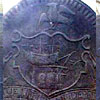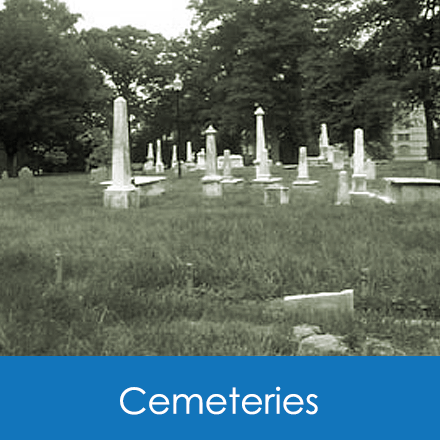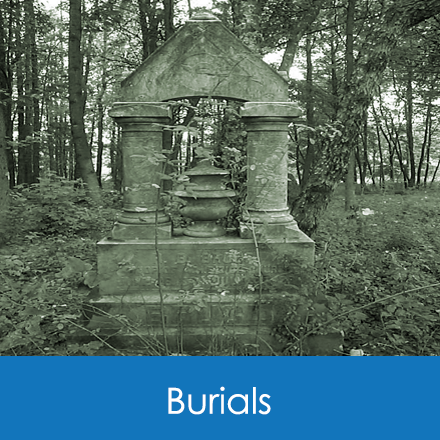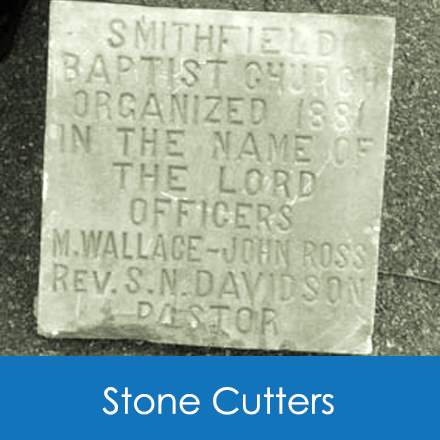You are here
Stone Cutters
Stone Cutters
The most famous early stone cutters in Mecklenburg County were the Bighams, who lived in the Steele Creek area. Their stones survive today not just in Mecklenburg but elsewhere in North and South Carolina. Their intricate designs and personal touches, such as coats of arms, made their work recognizable. They also trained others in their techniques so their traditions continued.
For more information on the Bighams and other early stone cutters, please read
- Sticks and Stones by M. Ruth Little, published by The University of North Carolina Press in Chapel Hill in1998
- Early Gravestone Art in Georgia and South Carolina by Diana Williams Combs, published by the University of Georgia Press in Athens in 1986
- Cemeteries & Gravemarkers, edited by Richard E. Meyer, published by UMI Research Press in 1989
- The True Image: Gravestone Art and the Culture of Scotch Irish Settlers in the Pennsylvania and Carolina Backcountry by Daniel Patterson, published by the University of North Carolina Press in Chapel Hill in 2012.
Some other early stone cutters in the 1800s were J. T. White and T. Walker. These artists developed a style that was their trademark and carved their names on their work. G. Brown of Columbia signed a stone in the 1820s. Several of his stones appear with later dates in this county but no longer have Columbia as his place of residence. It is unknown if he had moved to the area or just did a lot of business in Mecklenburg County.
Working with stone has always been a difficult job from the standpoint of working with hard materials. A good stone cutter needs artistic ability to design and execute lettering. The work of a stone cutter outlasts them and can be around for hundreds and thousands of years. Most occupations cannot claim that honor!
See this table of historic Meckleburg stone cutters.
See these historic advertisements for stone cutters:
- · Wm. Tiddy and Sons, 1857 newspaper ad
- · Ads from City Directories:
See this table of Stone Cutters / Businesses in Mecklenburg County, NC in 2001
Techniques
Chisels and hammers were the only tools of the trade until the beginning of the last century. Blacksmith skills were necessary to keep the wide variety of chisels sharpened for each task.
With the invention of compressed air tools, stone cutters were able to go faster, do more intricate designs and work with harder materials. Transportation improved and so did people's taste in materials. Materials from granite mines in Georgia, Vermont, and around the world were being shipped to Mecklenburg to meet the demand of the public.
Catalog shopping was also available. You could order your own stone from companies, like the ones shown in this 1900 ad from the Sears catalog.
Types of stones and words of sentiments are no longer just chosen by grieving relatives. Customers can now set up appointments to plan their own markers. They can select materials from precut slabs or samples, choose the type and style of lettering, add images, have the stone set in the cemetery and just wait until their death for that last date to be chiseled.
Selection of the stone is one of the most important decisions because durability is key. Once the selection is made, the stone cutter breaks the stone into the approximate shape, grinds any rough places and may polish or put on the finish desired by the customer. These steps can be done by hand or machine.
Design comes next. Getting everything to exact detail is of major importance. Early stone cutters would have had to lay out their designs with skill and experience.
Today, stencils are made by computers and are placed on a thin layer of rubber. The desired lettering and design is chiseled, sandblasted and/or done with laser. Double outlined lettering is done currently by stone cutters, which would not have been possible to the early stone cutters.
The final process is to clean and set the stone in the cemetery. Upright stones set on a base are more expensive but are less likely to sink or tip over because the weight is more evenly distributed.
Monuments
Burial markers in this county are mainly fieldstones, granite, marble, sandstone, or bronze emblems on a stone. Some recent burial plots have wooden crosses or wooden markers that will not stand the test of time. Even though a field stone does not bear the name of the deceased, at least it continues to mark a grave, if left alone by humans.
Styles in monuments have changed here, just like fashion. The types of carving, color of stone, insignias, height, foot stone and other choices made for the deceased make any cemetery visit a tour of art history also.
Very early stones in this area look like those often found in New England. They are usually of medium height, thin, curved on the top, and dark, if made from slate. They often tell biographical information about the person, such as a military rank, their spouse's name, and political, educational or religious contributions in life. Angels, sunrises, scrollwork and detailed designs were popular on stones from the late 1700s and early 1800s.
A little later in the early to middle 1800s, the stones were often chiseled with just the person's name, date of birth and death. There was a time when it was popular to not give the death date but to calculate the person's age in years, months and days. Plain and stoic were in vogue in both design and wording.
Gravestones styles changed again during the late 1800s and early 1900s and had a more Victorian approach with interesting works of art with sculpture, urns, flowers and elaborate columns. Enduring terms of the deceased were added to their stones, such as “precious,” “angel,” “beloved,” and “dear.” Lambs were often used on infant and children's stones.
The style soon reverted back to telling more biographical information about the person, either through words or design. Soldiers may have markers or flags on their tombstones to designate in which war they fought or to tell which battle was their last. Ancestors of soldiers that belong to patriotic groups or members of fraternal groupsmay also have carvings or additional emblems on their stones to designate their previous memberships in organizations. Members of the Woodmen of the World may have a tombstone with a tree carving, or their tombstone may be in the shape of a limb or stump.
Burial markers have often expressed people's religious beliefs in text and form. They are a memorial to the deceased and express the love and admiration of those left behind.
Cemeteries
The majority of the cemeteries and those oldest in this county belong to Presbyterian churches, reflecting the early settler's religious preference. Some churches have two sites, one usually abandoned when the church relocates to another area.
We do not have a military cemetery in Mecklenburg, but some cemeteries have sections set aside for veterans. Some cities of Mecklenburg County own cemeteries for their citizens but not all do.
The County Home was built in the northeast part of the county to assist less fortunate citizens. Gravestones for the Mecklenburg County. Home, also known as the “Poor House” or “Green Acres,” were purchased by the county government. They all contain the basic information about the deceased and are fairly identical in size, shape and carving. It is the only cemetery in the county that has the appearance of a military cemetery, in that the plots are all facing the same direction and the stones are similar.
Most other older cemeteries in the county follow the terrain and have stones that face the same direction. Stones may suddenly change directions in their placement due to additions to the cemetery or the need to add roads to accommodate automobiles.
When visiting a cemetery, it is often easy to find the area you want to research by looking at the height, color, thickness and type of stones, i.e. the older stones are never made of thick, pink granite with a high gloss finish. You can usually tell by the type of stones and the dates on stones when and where new additions have been made to a cemetery.
Many of the newer cemeteries owned by businesses have restrictions in the type of monument that can be purchased for the deceased. Flat stones or markers are now common place due to the desire to easily mow and maneuver within the cemeteries. These markers often face the many roads within the cemetery.
Fieldstones were used for people whose families could not afford or have access to carved monuments. They were also used to mark a grave until a more elaborate marker could be acquired. Sometimes the fieldstones will have marks scratched on the stones, but most are unreadable. These, along with evidence of periwinkle or perennial flowers, are often signs of a long-forgotten cemetery.
Some cemeteries have metal markers with the deceased's name and information on a card, enclosed by plastic. These are usually temporary markers provided by the funeral homes and will not stand up to the test of time.
The style of stones can vary from a basic slab to an elaborate column, multi-person stone or flat stone in a mausoleum. Due to the weather, tradition and water table, most of the people in Mecklenburg, historically and currently, are still buried underground in individual graves. For those that do choose to be buried above ground, the county has many beautiful memorials to those individuals or families.
The work of the stone cutters of Mecklenburg County has lasted for over 200 years. Ignorance and carelessness by family members or researchers are causing some of the stones to deteriorate at an unnatural rate. In order to get an accurate or clearer picture of what is written on stones, some people have put shaving cream or other chemicals on the stones. The residue can damage or stain the stones and cause enormous, permanent deterioration.
Using a mirror to illuminate tombstones for photographs is a much better way to achieve the objective. For more information about appropriate preservation and inscription techniques to use in a cemetery, please read A Graveyard Preservation Primer by Lynette Strangstad, published by the American Association for State and Local History in Nashville, 1988.
We should all work to preserve, protect and cherish the graves and stone work of these cutters for the true gifts of art that they are. Gravestones are Mecklenburg County's greatest historical art legacy!




